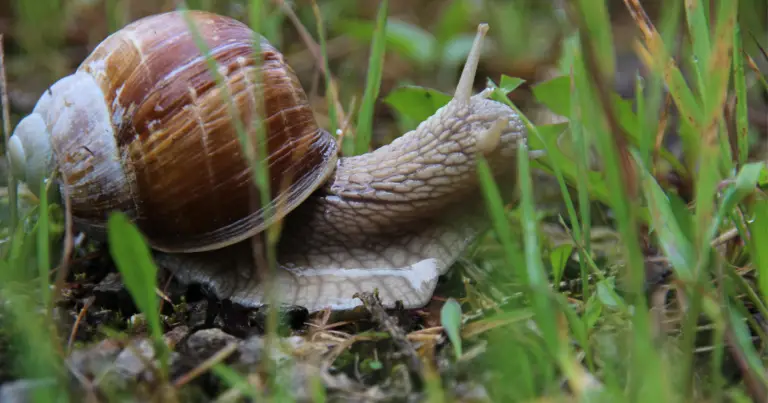Group of Snails: Exploring Their Behavior and Ecology

Snails are fascinating creatures that can be found in various habitats, including oceans, freshwaters, and on land. You may encounter different species of snails, thousands to be exact, all belonging to the gastropod mollusk family. These intriguing invertebrates exhibit exclusive features, such as their distinct spiral or coiled shells, and their slow, rhythmic movement by contracting their muscular foot while leaving behind slimy trails.
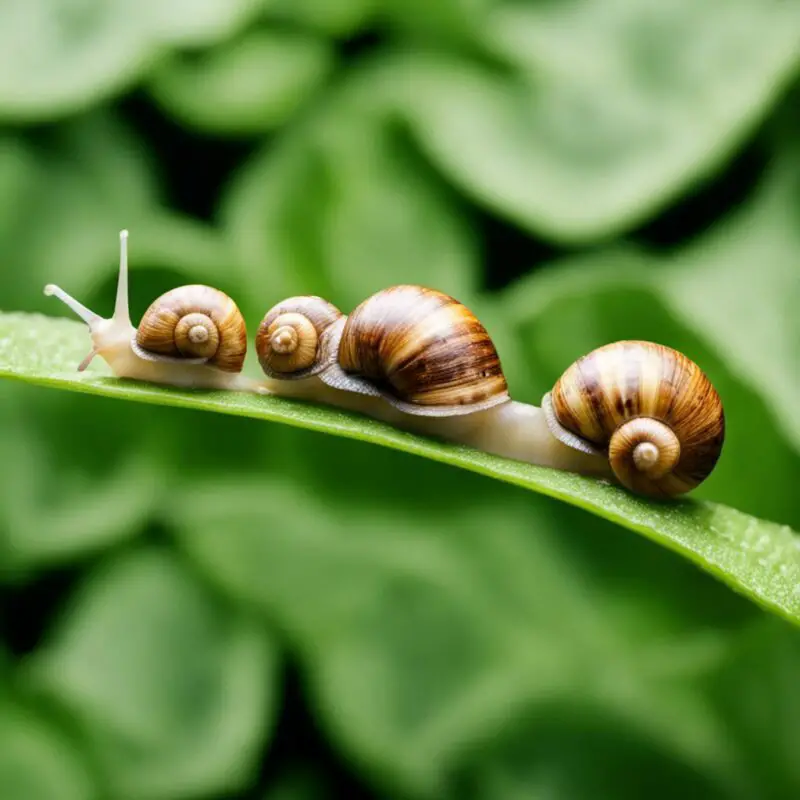
You may be curious about how snails interact when they come together. When faced with a group of snails, terms like rout, walk, or escargatoire are used to describe this congregation. You can find these snail assemblies across various settings, whether on land or in the sea. It is intriguing to witness these unique creatures come together, as each species has different characteristics and charm.
Contents
Table of Contents
Biology of Snails
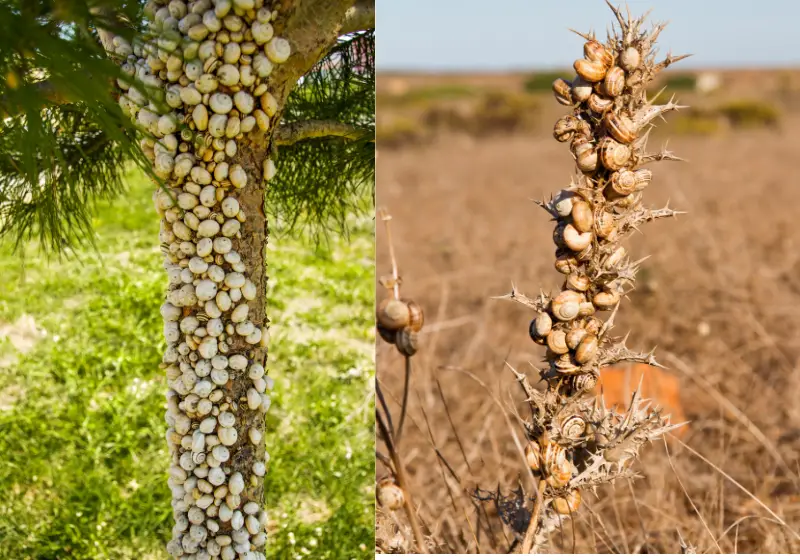
Physical Attributes
Snails belong to the Mollusca phylum, specifically within the class Gastropoda. The Gastropods include land snails and slugs, which are essentially snails without a shell. The most noticeable feature of snails is their shell, which is typically spiral-shaped and accommodates the snail’s size as it grows. The shell is designed to protect the snail from predators and the environment and act as a mobile home when the snail needs to find new food sources.
Snails have a muscular foot that they use for locomotion on various surfaces. Additionally, they have a specialized organ called a radula, which they use to scrape and ingest food.
Life Processes
Most land snails belong to the Pulmonata group, meaning they are equipped with a lung for breathing. In contrast, some marine snails have gills to extract oxygen from the water. Terrestrial snails use their lungs to breathe air, mostly living in moist environments to avoid dehydration.
As for feeding, snails are generally herbivorous and feed on various plant materials, fungi, and algae. Their radula allows them to consume their food efficiently, grinding it into tiny pieces for digestion.
Reproduction
Snail reproduction varies among species. In general, land snails can be hermaphroditic or have separate sexes. Hermaphroditic snails can self-fertilize or mate with another partner for genetic diversity. Once fertilized, eggs are laid in moist, hidden locations to incubate. After hatching, the young snails must feed on calcium-rich sources, like plant material or crushed eggshells, to help construct their shells.
Diversity
The Gastropoda class encompasses a vast diversity of snails, varying in size from less than 1mm to 91cm in length. This diversity includes more than land snails; there are also marine snails and freshwater snails. Over time, some snails have evolved to lose their shells, becoming what we now know as slugs.
There are numerous gastropod species worldwide, each adapted to its unique habitat. The terrestrial snail group, for example, primarily includes snails and slugs. They can inhabit various environments, from forests to deserts to urban areas.
Habitats and Distribution

Land Habitats
In your exploration of snail habitats, you’ll find that land snails can thrive in various environments, including forests, gardens, agricultural areas, and swamps. Soil composition is crucial for their survival, providing necessary nutrients and moisture for them to thrive.
North America, Europe, and Africa are continents where you can find land snails inhabiting various regions, with a high diversity in Europe due to its coiled species distribution.
Snails usually prefer moist and humid environments when living in land habitats, as they need to keep their bodies hydrated and their shells supplied with calcium. Snails are often found on the ground or within the soil, as they feed on decaying plants and lay their eggs in the earth. In your garden, you may find them moving among the foliage or surrounding areas, seeking food and moisture1.
Water Habitats
As you delve into water habitats, you’ll discover that snails can also be found in marine, freshwater, and brackish environments. Sea snails, for example, inhabit various ocean zones, being most abundant close to and just below tidal zones2. They can feed on algae and other available food sources in these areas. Marine gastropods, like conch, abalone, and limpets, are essential to many ocean ecosystems.
Regarding freshwater snails, you’ll find them in various freshwater bodies, including ponds, lakes, rivers, and streams. The evolutionary shift from marine to freshwater habitats required physiological and behavioral adaptations.
Freshwater snails contribute to the biodiversity of these ecosystems, sometimes forming a significant portion of the local fauna. In addition, snails are essential for maintaining water quality, consuming algae and other particles, and keeping aquatic habitats clear and healthy.
By understanding the diverse range of environments where snails live, you can appreciate these creatures’ remarkable adaptability and their vital role in different ecosystems.
How to Care for Pet Snails! Watch this
Snails as Pets and Cuisine
Pet Snails
Snails can make unique and fascinating pets for various reasons. They are quiet, don’t shed or smell, and require less space and maintenance than many other pets. Watching them move slowly and peacefully can be incredibly relaxing for you. A popular variety of pet snails is the brown garden snail (Cornu aspersum) 1. Setting up and feeding their habitat is relatively simple, making them suitable companions even for pet-keeping beginners.
Snail Cuisine
While it might surprise some, snails have been a part of global cuisine for centuries. Edible land snails, often called escargot, are considered a delicacy in many cultures 3. Escargot dishes typically feature snails cooked with garlic, butter, and parsley, serving as an appetizing and protein-rich meal.
In addition to fully grown snails, snail eggs, also known as “pearls,” are gaining popularity as a luxurious food item. They often feature on menus in high-end restaurants, pleasing the palates of adventurous food enthusiasts.
One noteworthy species in the culinary world is the giant African land snail. These snails are popular pets and offer a significant source of protein and fat when consumed as food. However, it’s essential to note that they’re considered invasive in some countries, so you should consult local regulations and guidelines before keeping or consuming them. 2
Remember to be mindful and well-informed regarding snail cuisine, respecting the cultural context and the ecological implications of consuming these unique creatures.
Snail Behavior

Movement Patterns
Snails primarily move using their muscular foot, which is covered with a slime layer to help them glide smoothly across various surfaces. As you observe snails, you’ll notice a wave-like motion in their foot, allowing them to slide slowly but steadily.
Some marine snails, like the ones from class Gastropoda and phylum Mollusca, may use additional appendages or float in water currents to assist their movement.
Survival Mechanisms
Snails have developed several survival mechanisms to protect themselves from predators and environmental dangers. One notable feature is their shell, which acts as a shield and can be retreated into when they sense danger. The shell is part of their mantle, a specialized tissue responsible for shell growth.
Furthermore, snails undergo torsion, a developmental process that repositions their internal organs for better protection.
In addition to their protective shells, snails can also hibernate during harsh conditions, remaining dormant for extended periods to conserve energy. Their ability to seal their shell’s opening with a mucous layer helps them retain moisture and stay safe while hibernating.
Feeding Habits
Snails exhibit diverse feeding habits, varying based on their species and habitat. Most snails are herbivores, feeding on plant matter, algae, and fruits. Some species, like the Lymnaea species, are known to be omnivores, consuming both plant and animal matter. There are even carnivorous snails, such as the Syrinx aruanus, that hunt small invertebrates.
An interesting aspect of snails’ diet is their radula, a specialized and flexible organ with numerous tiny teeth in rows, helping them scrape off food from surfaces. Snails belonging to the Heterobranchia group are equipped with stalked eyes at the end of their upper tentacles, which allow them to detect food and avoid obstacles while foraging.
In conclusion, snail behavior is a fascinating topic encompassing a variety of movement patterns, survival mechanisms, and feeding habits. These fascinating invertebrates have adapted well to their environments, making them unique and essential organisms within many ecosystems worldwide.
Snails and Humans
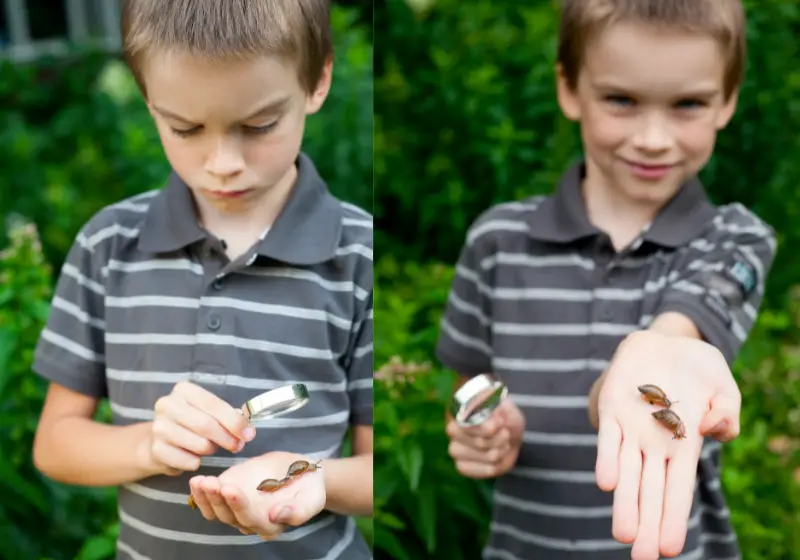
Intrusion in Gardens
You may have encountered a group of snails invading your garden as a gardener. In countries like the UK and France, these molluscs can be a nuisance due to their feeding habits. Snails can consume various plants and may cause serious damage to your garden.
During periods of high temperature or dry weather, snails undergo a process called estivation. They clump together and form a seal to conserve moisture, making it easier to find a collection of snails in your garden.
Understanding the snails’ biology is essential to help protect your plants. Snails have an elongated, soft body with a prominent head and retractable tentacles. The head houses their internal organs, including the ability to process what they consume. Although snails are considered invertebrates, they are not insects. They belong to the phylum Mollusca, meaning they are molluscs.
Medical Uses
Despite the issues snails may bring to your garden, they also offer various benefits. For example, the medical field has recognized the value of snails in research and treatment applications. In France, snails have been used as a traditional medicine for centuries, particularly for treating ailments related to the stomach and skin.
Snail content, such as their mucous, is rich in proteins, enzymes, and antioxidants, making it beneficial in skincare products.
Snails have also been studied for their potential use in pain management. The venom of some snail species contains compounds that act on the nervous system, providing analgesic properties. Although currently in the research phase, these findings open the door to understanding and potentially developing new medications from snail-derived substances.
As you can see, the relationship between humans and snails is multifaceted. While they can be a nuisance in your garden, their unique biology and various medical uses showcase the importance of understanding and respecting this diverse group of molluscs.
Frequently Asked Questions: Group of Snails

What is the collective term for snails?
A group of snails is often called an escargatoire, walk, or rout. These terms can be used interchangeably to describe a collection of snails found together, regardless of their location.
Are there different groups of sea snails?
Yes, sea snails form groups similar to their land counterparts. The collective terms escargatoire, walk, and rout also apply to groups of sea snails. Snails may be found in various habitats, including freshwater and marine environments.
Do snails belong to any specific animal subgroup?
Snails belong to the animal kingdom’s phylum Mollusca and class Gastropoda. Gastropoda is a diverse group that includes both aquatic snails and slugs. Snails, being mollusks, are also related to other mollusks such as octopuses. You can learn more about their classification here.
Are any species of snails poisonous?
While many snail species are harmless, some can be toxic or dangerous to humans. The cone snail is an example of a venomous marine snail. Their venom contains toxins that can cause serious illness or even death in humans. If you encounter a snail and are unsure of its species, it’s best to exercise caution and avoid handling it.
Snails generally have minimal social interactions, although they sometimes form short-term aggregations in certain situations. Snails may group together to reproduce or take advantage of abundant food sources. However, these groupings are typically temporary and not indicative of complex social dynamics or hierarchies.
How do snails communicate within their groups?
Snails communicate mainly through the use of chemical signals and touch. As they have limited vision and hearing capabilities, snails rely on their sense of smell and tactile sensing abilities to navigate their environment and interact with other snails. Snails secrete mucus that helps them slide and leaves a trail behind them which can be sensed by other snails, allowing them to follow or avoid each other as needed.

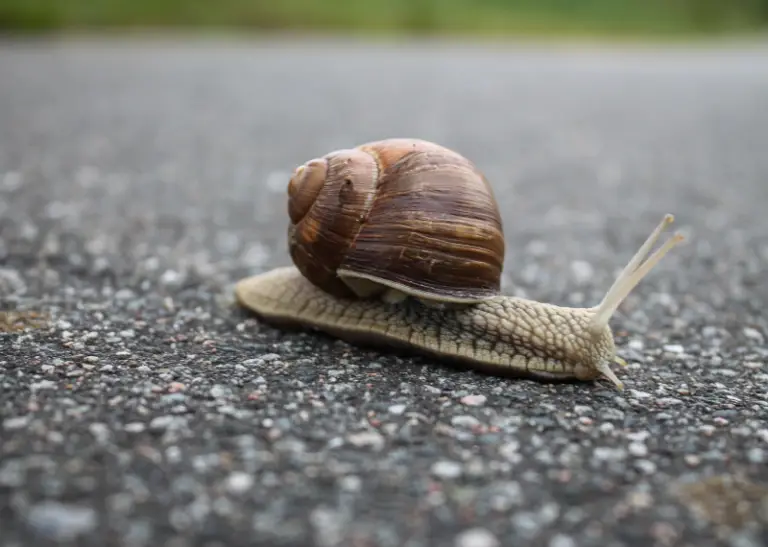
![Can You Eat Apple Snails? [Read This First!]](https://allourcreatures.com/wp-content/uploads/2021/11/eating-snails-768x514.jpg)



